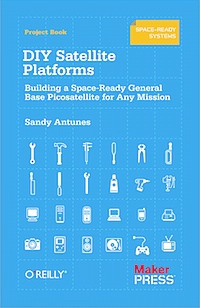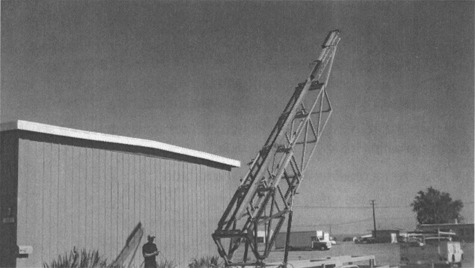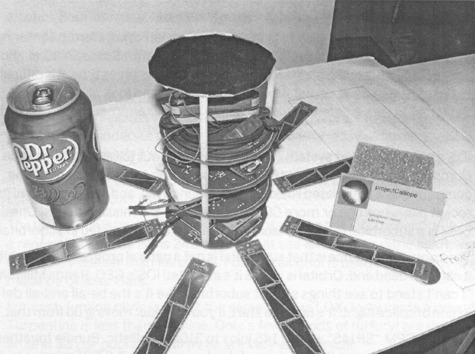
Leandro Pereira
Shared posts
Linux Kernel To Get AIO Performance Improvements
Leandro PereiraAIO do Linux é tão zoado que compensa (hoje) fazer tudo na mão em userland mesmo...
some cold mass and no fucks coming from the south

some cold mass and no fucks coming from the south
this basically describes my job

this basically describes my job
Paper-Based 3D Printing Process
 Phil mentioned Ireland's Mcor Technologies when they premiered on Gizmodo back in 2008. Their monochrome Matrix 300+ printer builds models by laminating regular copy/printer paper using controlled application of adhesive and 2D-mechanical cutting on each layer. Now, Mcor is at work on Iris, a prototype design that implements a full-color version of their process, presumably adding a color printing step, of some sort, on each sheet of paper. Check the video below to see some early results.
Phil mentioned Ireland's Mcor Technologies when they premiered on Gizmodo back in 2008. Their monochrome Matrix 300+ printer builds models by laminating regular copy/printer paper using controlled application of adhesive and 2D-mechanical cutting on each layer. Now, Mcor is at work on Iris, a prototype design that implements a full-color version of their process, presumably adding a color printing step, of some sort, on each sheet of paper. Check the video below to see some early results.
USB Keyboard Becomes an AVR Programmer
Leandro PereiraCool.
[Steve] created an AVR programmer using an old USB keyboard. We feature a bunch of AVR programmers, but this one is made from parts that many people will have lying around. There are two components: the controller PCB from a USB keyboard, and an optocoupler for emulating key presses.
In order to send data to the AVR, [Steve] used the LED outputs on the keyboard. These LEDs can easily be toggled according to the HID device specification. They provide a 5 volt output with current limiting resistors, which means they can be connected directly to the target AVR.
Reading data is a bit more complex. The optocoupler tricks the keyboard into believing that a single key has been pressed, firing off a data transfer. The MISO pin on the AVR is connected to the row and column of the shift key, which is read by the driver.
On the software side [Steve] created an avrdude interface driver. This allows the programmer to be used with avrdude, just like any other programmer. [Steve] does point out that it isn’t the fastest programmer since the keyboard tries to debounce the MISO input, greatly limiting the speed. However, since it’s made from stuff you might have in your junk bin, it’s a neat hack.
Filed under: Microcontrollers
The Rules Do Not Apply

Submitted by: Unknown (via Sofa Pizza)
Tagged: gifs , kids , lift the system , kmfdm , the rules do not apply Share on FacebookThe Root Kit Movie
If you want to help a great movie get made you might want to through a few dollars towards The Root Kit movie by Jonathan Schiefer. I just recently heard about this on Frame Rate (go to 3:10 to see the interview about the movie) and the plot sounds great. They are going to make it on a shoestring budget as far as movies are concerned but based on Jonathan’s background it sounds like he can make it happen. There are lots of interesting levels of sponsorship, for example $4 will get your name in the credits, $64 will allow you to have some of your code to get distributed with the movie.
Solitaire.exe: Card Deck based on the Original Procrastinator

Evan Roth hat ein limitiertes Poker-Deck drucken lassen, basierend auf den Original-Designs von Microsofts Solitaire-Game von Susan Kare.
A simple piece of software got us through the dark ages of computing before the Internet allowed us to waste company time more effectively. Now you can reconnect with this old friend on the other side of the computer screen. Solitaire.exe is a physical pixel-for-pixel recreation of the popular computer card game included in the Windows 98 operating system.
Solitaire.exe (via Nerd Gold)
Machine Gun Jetpack-Physics
 Randall “xkcd” Munroe rechnet auf seinem tollen neuen Blog “What if?” aus, wieviele Maschinengewehre man bräuchte, um sie als Jetpack benutzen zu können. Rocketscience mit Guns, tatsächlich.
Randall “xkcd” Munroe rechnet auf seinem tollen neuen Blog “What if?” aus, wieviele Maschinengewehre man bräuchte, um sie als Jetpack benutzen zu können. Rocketscience mit Guns, tatsächlich.
The GAU-8 Avenger fires up to sixty one-pound bullets a second. It produces almost five tons of recoil force, which is crazy considering that it’s mounted in a type of plane (the A-10 “Warthog”) whose two engines produce only four tons of thrust each. If you put two of them in one aircraft, and fired both guns forward while opening up the throttle, the guns would win and you’d accelerate backward.
To put it another way: If I mounted a GAU-8 on my car, put the car in neutral, and started firing backward from a standstill, I would be breaking the interstate speed limit in less than three seconds.
How goatse.cx went from shock site to webmail service
Leandro PereiraLOL
People from my Internet generation, those who came online in the mid-1990s, have rose-tinted memories of early Web "shock sites"—sites with unassuming URLs containing horrible pictures of awful things. As the moniker implies, stumbling onto one (or being tricked into viewing one by friends) usually resulted in a dropped jaw and maybe an overwhelming wave of revulsion, followed almost immediately by the urge to show it to someone else to watch their reaction. The great grandaddy of all shock sites is the infamous goatse.cx, which featured an unspeakably awful image which I admit setting as the wallpaper on friends' computers to more than once (BJ, if you're reading, I'm sorry, but it was hilarious every time).
The shock site has been offline for a number of years now, primarily due to a dispute with the Christmas Island Internet Administration over misuse of the .cx TLD country code, but recently the goatse.cx URL began displaying something a lot more pleasant than the original picture.
Goatse goes webmail
Ars spoke with the webmaster behind the reborn goatse.cx site, whom we'll call "Bob." Bob has asked, understandably, that we not use his name in this story—although the webmail service won't have anything to do with the shock content of the original site, the personal and professional implications of having one's name associated with "goatse.cx" could be significant.
Clang Can Analyze Code Comments, Generate Docs
Leandro PereiraEstava procurando isso outro dia, para matar o Doxygen. :)
7400 Logic Competition winners announced
Leandro PereiraAinda não vi as entradas, mas espero encontrar coisas tão doidas quanto aquele concurso de 555.

The 7400 Logic Competition has drawn to a close. The winners were announced and there are quite a few of them. There were fifteen first place winners named, nine second place, and nineteen third place projects. The bounty of quality entries is a testament to the popularity of the contest. It helps to have a wide range of prizes and the post linked above lists all of the sponsors who donated goodies as an incentive.
The board seen above was awarded the reader’s choice, to which the grand prize was awarded. It is a 7400 series calculator. [Umair Mukati] and [Naveed Ahmed] — both are students at the Institute of Industrial Electronics Engineering in Karachi, Pakistan — developed the device as part of a class project. It is capable of adding or subtracting two digit numbers. This includes support for negative numbers as results. We’ve embedded a video demo of the calculator in action after the break.
[Thanks Nick]
Filed under: contests
Haiku Release 1 Alpha 4

The Haiku Project is excited to announce the availability of our fourth official alpha release. A year and four months have passed since the Alpha 3 and the Haiku Project has been busy. The main purpose of this release is to provide interested third party developers with a stable version for testing and development. To aid with that, Haiku includes a rich set of development tools.
DIY Satellite Platforms
Leandro PereiraMontar e lançar um satélite tá na minha lista de projetos a fazer.

You can send a do-it-yourself satellite into space, one that piggybacks on a commercial rocket. This pico-satellite must conform to a set of dimensions about the size of a soda can. The minimum price of a launch is $12,000 and dropping. All the other rules, constraints, and questions you’ll need to build are covered in this very basic intro. Author Sandy Antunes is writing a master guide one small booklet at a time so check out his other titles in this series.
-- KK
DIY Satellite Platforms
Sandy Antunes
$8
2012, 86 pages
Available from Amazon
Sample Excerpts:
Size and weight build model for a tubesat-type 1kg limit picosatellite*
First: where will your picosatellite go? It’s nearly a given that your picosatellite will go to low earth orbit (LEO), a broad band ranging from about 150km up to perhaps 600km.
Above the ionosphere, the space environment can be hostile because of solar activity. Below it, the radiation risks are much lower. This is why the ISS is kept in LEO. LEO is, at heart, about as safe as space can get. It’s also where your picosatellite is likely to live.
Your orbit is entirely determined by what your rocket provider has sold you. At the hobbyist level, you’re going to most likely get a standard 250km or so nearly circular orbit, either equatorial or polar. Such an orbit lasts (because of drag by the tenuous ionosphere) from 3 to 16 weeks before the satellite will suffer a fiery reentry.
At picosatellite masses, this means your satellite will go up and not return. You have less than three months to gather data. The picosatellite will then, essentially, vaporize neatly upon reentry (no space junk risk!)
*
Let’s close with the idea of flight spares. The idea here is twofold. First, it is good to have a second satellite ready in case a mishap occurs to the first. Mishaps can range from rocket blew up all the way down to a mundane dropped it while carrying it to the truck.
Conceptually and more important, you want to build two or three satellites simultaneously for two reasons. First, you may make a construction mistake with one. Having a spare means you can continue to work without having to wait for new parts or fabrication.
Second, you will build one better than the other. Statistically, one of your builds will have better performance than the other. This better one is the one you will fly. By creating multiple builds, you give yourself and your skills a chance to practice, hone, and ultimately create a better picosatellite.
So build two and fly the one that does best in tests.
*
The lowest fixed-price offering out there is InterOrbital Systems offering 1kg TubeSat launches for $8,000 (including a TubeSat kit) or a 1kg 1U CubeSat launch for $12,500. The company is still building toward its first launch, however.
 InterOrbital Systems CPM mobile launch rail (image Copyright InterOrbital Systems 1996-2011)
InterOrbital Systems CPM mobile launch rail (image Copyright InterOrbital Systems 1996-2011)
Each photo is 12 minutes apart, assembled with no measurements...

Each photo is 12 minutes apart, assembled with no measurements in place (obviously) with Photoshop. No exposure adjustments or color compensations.









